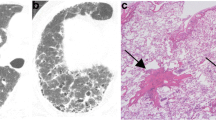Abstract
We studied the effects of age, body mass index (BMI) and some common laboratory test results on several pulmonary CT/HRCT signs. Five hundred twenty-eight construction workers (age 38–80, mean 63 years) were imaged with spiral and high resolution CT. Images were scored by three radiologists for solitary pulmonary nodules, signs indicative of fibrosis and emphysema, ground glass opacities, bronchial wall thickness and bronchiectasis. Multivariate statistical analyses were adjusted for smoking and asbestos exposure. Increasing age, blood haemoglobin value and erythrocyte sedimentation rate correlated positively with several HRCT signs. Increasing BMI was associated with a decrease in several signs, especially parenchymal bands, honeycombing, all kinds of emphysema and bronchiectasis. The latter finding might be due to the suboptimal image quality in obese individuals, which may cause suspicious findings to be overlooked. Background data, including patient’s age and body constitution, should be considered when CT/HRCT images are interpreted.


Similar content being viewed by others
References
Remy-Jardin M, Remy J, Boulenquez C, Sobaszek A, Edme JL, Furon D (1993) Morphologic effects of cigarette smoking on airways and pulmonary parenchyma in healthy adult volunteers: CT evaluation and correlation with pulmonary function tests. Radiology 186:107–115
Vehmas T, Kivisaari L, Huuskonen M, Jaakkola MS (2003) Effects of tobacco smoking on findings in chest computed tomography. Eur Respir J 21:1–6
Verschakelen JA, Scheinbaum K, Bogaert J, Demedts M, Lacquet LI, Baert AL (1998) Expiratory CT in cigarette smokers: correlation between areas of decreased lung attenuation, pulmonary function tests and smoking history. Eur Radiol 8:1391–1399
Tiitola M, Kivisaari L, Huuskonen MS, Mattson K, Koskinen H, Lehtola H, Zitting A, Vehmas T (2002) Computed tomography screening for lung cancer in asbestos-exposed workers. Lung Cancer 35:17–22
Huuskonen O, Kivisaari L, Zitting A, Taskinen K, Tossavainen A, Vehmas T (2001) High resolution computed tomography classification of lung fibrosis in patients with asbestos-related disease. Scand J Work Environ Health 27:106–112
Webb WR, Müller NL, Naidich DP (1996) High-resolution CT of the lung, vol. 2. Lippincott-Raven, Philadelphia
Meyer JD, Islam SS, Ducatman AM, McCunney RJ (1997) Prevalence of small lung opacities in populations unexposed to dusts. A literature analysis. Chest 111:404–410
Zitting A (1995) Prevalence of radiographic small lung opacities and pleural abnormalities in a representative adult population sample. Chest 107:126–131
Guerra S, Sherrill DL, Bobadilla A, Martinez FD, Barbee RA (2002) The relation of body mass index to asthma, chronic bronchitis, and emphysema. Chest 122:1256–1263
Chen Y, Breithaupt K, Muhajarine N (2000) Occurrence of chronic obstructive pulmonary disease among Canadians and sex-related risk factors. J Clin Epidemiol 53:755–761
Hubbard R, Venn A (2000) Adult height and cryptogenic fibrosing alveolitis: a case-control study using the UK general practice research database. Thorax 55:864–866
Acknowledgements
We would like to thank Dr. Hannu Lehtola for the patient interviews and Dr. Anders Zitting for the image analysis. The Finnish Work Environment Fund and the Federation of Accident Insurance Institutions supported the original data collection.
Author information
Authors and Affiliations
Corresponding author
Appendix: Criteria for assessing the radiological signs
Appendix: Criteria for assessing the radiological signs
Solitary nodules (scale 0–1): recorded 0 if no nodules were found and 1 if one or more nodules were found.
Radiological signs (scale 0–5: fibrosis score, subpleural septal lines, parenchymal bands 2–5 cm in length, honeycombing, ground glass opacities, centrilobular, paraseptal and panlobular emphysema, bullae):
-
0= normal
-
1= faint or few abnormalities, usually in a single slice
-
2= more distinct abnormalities
-
3= clear abnormalities in several slices
-
4= score between 3 and 5
-
5= severe abnormalities widely distributed in the whole lung, in all or most slices
Radiological signs in scale 0–3:
-
0= normal
-
1= a single faint dependent opacity, a faintly thickened bronchial wall in one to two bronchi or mildly dilated bronchi
-
2= a clear dependent opacity in 1–3 slices, several bronchi with thickened walls, or 1–3 saccular bronchiectasis
-
3= dependent opacities in most slices, several bronchi with distinctly thickened walls, or bronchiectasis widely distributed in the lungs
Rights and permissions
About this article
Cite this article
Vehmas, T., Kivisaari, L., Huuskonen, M.S. et al. Scoring CT/HRCT findings among asbestos-exposed workers: effects of patient’s age, body mass index and common laboratory test results. Eur Radiol 15, 213–219 (2005). https://doi.org/10.1007/s00330-004-2552-5
Received:
Revised:
Accepted:
Published:
Issue Date:
DOI: https://doi.org/10.1007/s00330-004-2552-5




